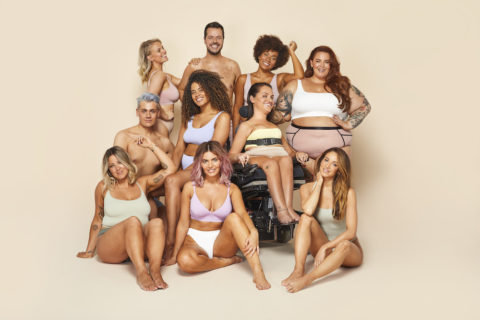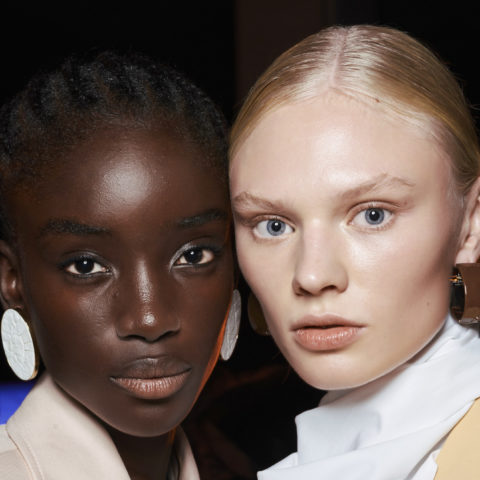Meet Isle of Paradise, a Line of Colour-Correcting Self Tanners
Why didn’t someone think of this before?
After working with brands like St. Tropez, tanning everyone from Kate Moss to Kendall Jenner, whether backstage at London Fashion Week or for the red carpet, and being the resident spray tanner on Dancing with the Stars, Jules Von Hep could write a thesis paper on the intricacies involved in achieving the perfect faux tan. “Isle of Paradise is basically my 10-year career in a bottle,” says Von Hep of his collection of tanning products, which landed at Sephora in Canada earlier this year.
Sitting on shelves, the line could easily be mistaken for a new skincare brand. The Self-Tanning Water, which is as easy to use as a facial mist, and Self-Tanning Drops, designed to be mixed into your facial or body moisturizer, are housed in clear bottles and come in shades like violet, green and peach. They’re the colour-correcting hues Von Hep has brilliantly mixed into his formulas, which are also vegan, organic and cruelty free, scoring Isle of Paradise Sephora’s Clean Beauty seal.
And while many self tan brands promote their product using images of lithe women sunbathing by the pool, Isle of Paradise prioritizes inclusivity and body positivity, featuring a broad mix of male and female models. “We were the first self tan brand to feature a curve model, which yes, it’s an accolade, but also, it’s really crap that one else had done it before,” says Von Hep, who makes a cameo in #ownyourglow, the brand’s latest campaign. “We’re also the first brand to feature a woman of colour, because self tanners are suitable for all skin tones, not just people with pale skin.”
Here, Von Hep shares some self tanning wisdom, like the reason traditional self tanners are often brown, why Brits and Aussies consider self tanners their desert island product, and the product that’s the self tan equivalent of Ctrl-Alt-Delete.
How did you get your start in spray tanning?
When I was assisting celebrity facialist Nichola Joss, she said ‘I think you’d be really good at spray tanning,’ and I was like [sighs] ‘spray tanning? I don’t know.’ She thought I would be good at it because of my personality and my discretion. The job requires going into people’s private spaces and asking them to take off their clothes and then letting me spray tan them, and in some cases they are celebrities.
At St. Tropez, you worked with Nichola as well as James Read, who went on to create his own self tanning line. Is it just me or do all the best self tan experts come from the UK?
When we started working together, tanning was not cool. It was all about orange footballers’ wives. Michelle Feeney [former CEO of St. Tropez who has been credited with turning the once struggling brand around], said we need to make this cool. So we were part of that initial movement.
In the UK, tanning is an integral part of our beauty routine: it’s hair, makeup, nails, tan. I think it’s the same in Australia. Self tan is so important there because of sun safety. Self tanner is one of those products that makes you feel good when you’re naked, and it’s semi-permanent so there’s a commitment. And you form this connection with it. And once you start tanning, it boosts your confidence.
What did working on Dancing with the Stars teach you about tanning?
It required doing tans every single week on the same skin tone, and making sure that it translated on national television. I really learned about tanning in such an in-depth way, for instance how different times of the month can affect how a woman takes a tan on her skin.
How did you come up with the idea for colour-correcting self tan collection?
After tanning my clients, even though they thought it looked perfect, I would think it was lackluster. I’m a Virgo. I love perfectionism, and so for me it wasn’t good enough. That’s why I started experimenting with colour pigments and mixing them into the instant tanner I was using to create the finish that my clients wanted, whether that meant minimizing yellow undertones using a violet pigment, hiding redness using a green pigment, or brightening the complexion using peach pigment. But with all of this extra stuff, my kit was enormous, and I thought ‘I need to make this kit smaller [by combining colour-correction pigment and tanner into one product].’ There wasn’t anything on the market that could do both, and so I realized I would need to make them myself.
How do the tanning waters work?
The waters are completely transparent when they go onto the skin and then they turn into a tan. Because there is no guide colour [Ed. note: this is the colour added to self tanning products that allows you to see where you’re going when you’re applying it], I can tan my clients and they can go to bed right after and wake up in the morning with nothing on the sheets. It means that you can put on a white shirt after using it. People keep the waters in their office desk drawer and spray their face just to top up their tan. It’s changed the way that men and women are tanning.
Isle of Paradise has really shaken up the self tan category. What has the response been like from consumers?
People are surprised about the lower price point. They also can’t get their head around the fact that the products don’t smell. I will never go on social media and say ‘it doesn’t smell,’ because everybody smells something different, but personally I can’t smell it. I always regram and retweet all the comments I get that say ‘this doesn’t smell’ because the proof is in the pudding.
Do your products use dihydroxyacetone (DHA)?
Yes, we source organic DHA (which comes from the sugar beet) from a farm in France. A lot of people think DHA is brown in colour, but it’s a misconception. It’s actually transparent. There was this placebo effect where people used to think ‘I’m buying a self tanner so it needs to look like a tan when I put it on.’ But actually it doesn’t. And now they’re saying, ‘oh my God, this is game changing.’
What should we do if we want to remove a tan?
Over It is our glycolic micellar water tan remover. I named it after my ex boyfriend. You spray it onto a tan, lather it up and exfoliate using gloves. It will just strip off any old tan.
Can you use it to fix a mistake?
You can soften it, but once a tan is on it needs a little bit of time to wear away on the skin, and then you can use Over It. If you do make a mistake, my advice is always to go over it with another layer of tan and that will conceal the mistake.
Do you have any other self tanning tips you can share?
Tan is like makeup. It’s all about buffing and blending. If you’re buffing, using dry face cloths or sponges or body beauty blenders will minimize the chance of streak. If you moisturize hands, elbows, knees and feet using aloe vera rich body butter you’re going to minimize the chance of [blotching.]








